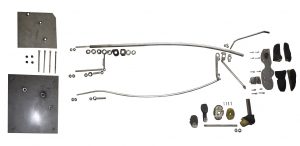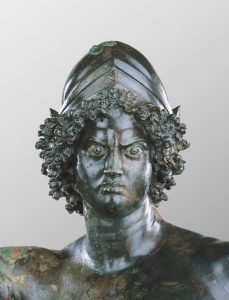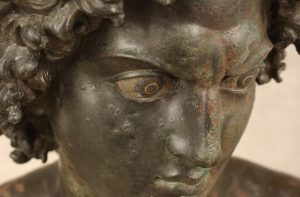Intervention
After discovery, the statue was immediately transported to storage at the nearby Archaeological Museum of Gaziantep. In March 2001, the statue received conservation treatment thanks to funding from the Packard Humanities Institute (PHI). The intervention was concluded in 2003.
Supports were built for the sculpture and for the other large object found (a lamp). They were specially designed to support the unstable parts and distribute the weight in an efficient way, thus facilitating the long process of cleaning the surfaces. These supports, mounted on wheels, allowed for smooth transport, reducing the dangers linked to handling during treatment.
A year of careful and scrupulous work to gradually remove the incrustations brought to light the true forms of the statue, the traces of ancient workmanship, and revealed, in the best preserved areas, a smooth and compact surface and a stable and aesthetically pleasing patina. Decorative details of extraordinary refinement, such as the eyes in silver and gold inlay, or the elaborate and fine chiseling on the disk of the lamp, suggest the works may be attributed to an expert sculptor, who worked to high standards for a wealthy and exigent client.
The cleaning, performed mechanically with scalpels and abrasive disks, was gradual and focused. The layers of accretions, which varied in nature and consistency, were progressively reduced area by area. To facilitate the removal of thick layers of earth, compacted by the presence of carbonates, localized poultices with alcohol and acetone were applied to soften the soluble components of the surface deposits, thus allowing them to be removed in a controlled way without exerting pressure on the original materials. The hollow interior of the sculpture was also cleaned. Using a fiber-optic endoscope, it was possible to take samples of the earthen deposits on the interior and establish, through analysis, that they had not been part of the casting process.
The statue was repeatedly washed to extract the soluble salts. For this purpose, it was necessary to build a glass basin slightly larger than the statue, equipped with straps that allowed to support the piece when immersed and to lift it for rinsing. Lightly heated and agitated distilled water was used for washing. By testing the conductivity of the water, it was possible to follow the progression of salt extraction and decide how many baths would be needed before the values of the water were stabilized. The baths, some ten in all, were repeated until stable conductivity values were attained, and were followed by chemical and heat drying.
The numerous fractures in the surface have been reinforced and sealed with epoxy resin colored with natural pigments. This was necessary to prevent future movements of fractures that would have consequently increased the fragility of the sculpture. With the same resin loose parts were glued to the solid structure. None of the gaps in the surface were integrated for aesthetic reasons.











